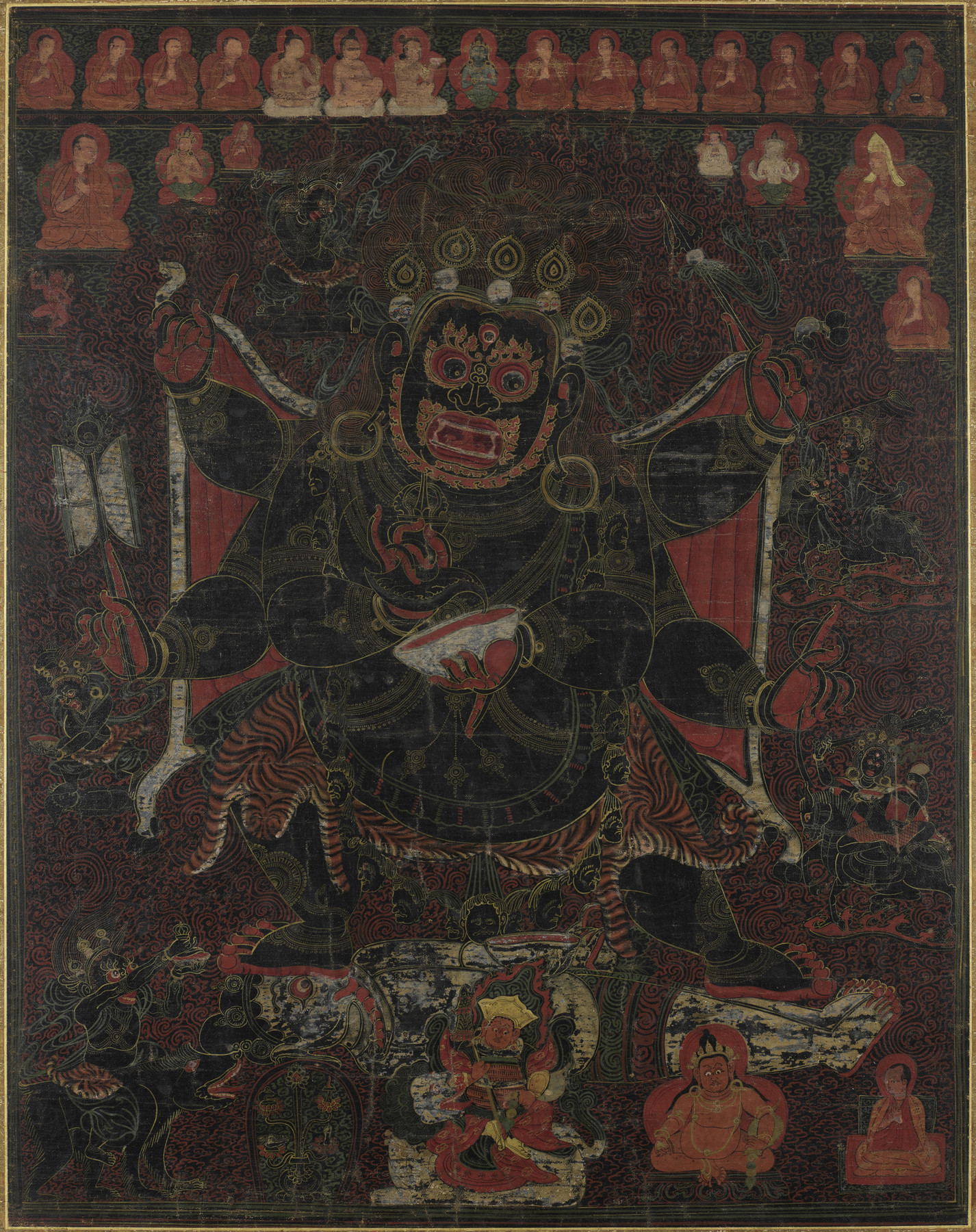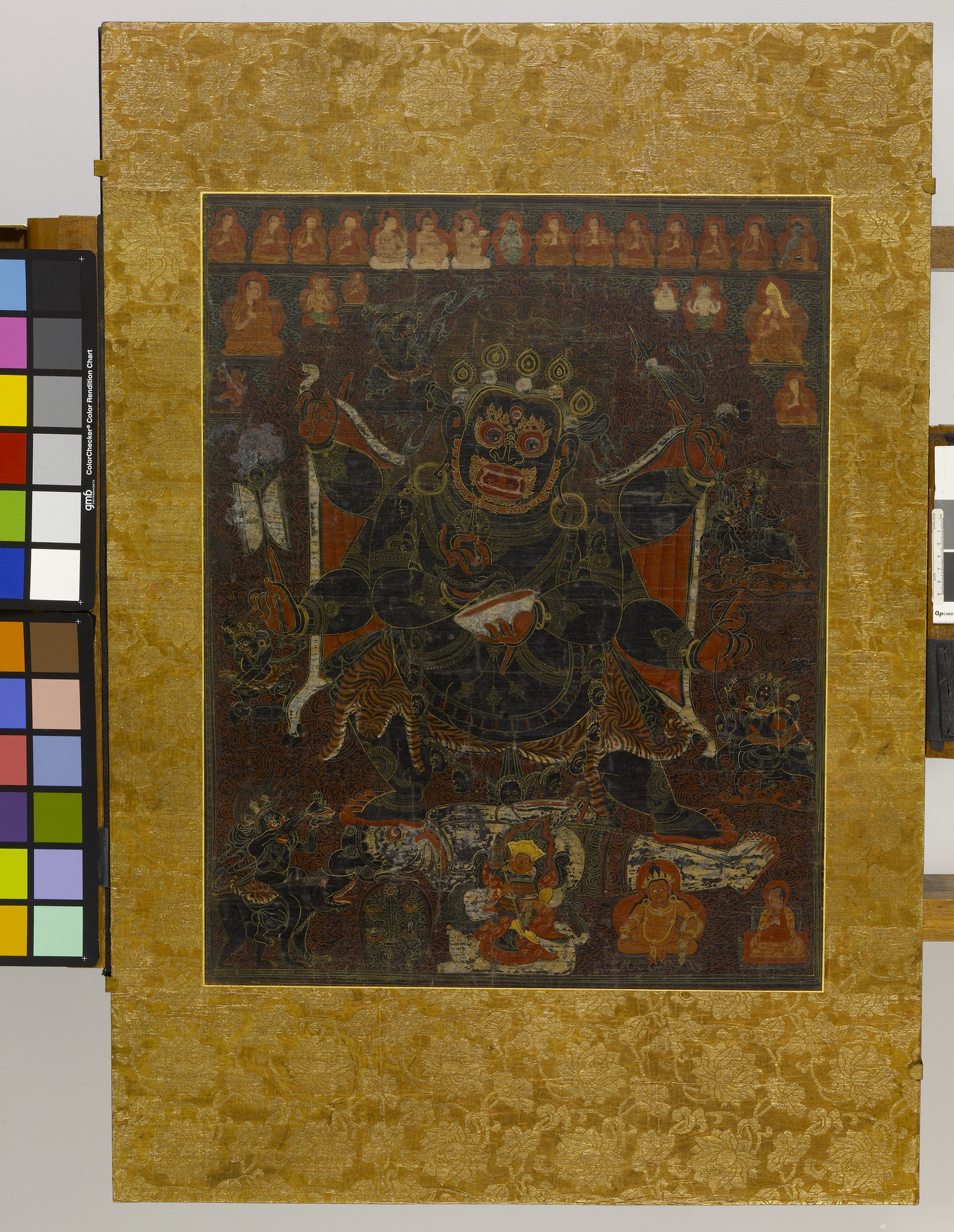Six-Armed Mahakala with Retinue and Monastic Lineage
(India, Nepal, and Tibet)
Positioning his corpulent body in a forceful lunge, glaring outward in anger with his three bulging eyes, and roaring furiously through his fang-rimmed mouth, the deity Mahakala fills this painting with his wrathful presence. A prominent protector of the Buddhist teachings, his rage is directed at negative forces—such as ignorance, hatred, and desire—that hinder a pursuit of the Buddhist path to enlightenment, the supreme knowledge that leads to spiritual liberation and an end to suffering. The elephant-headed figure he tramples, Ganesha, is best known as a Hindu god but in this context represents the delusion and worldly attachments that must be overcome to realize one’s innate potential for enlightenment.
In his six-armed form, Mahakala is considered to be an emanation of Avalokiteshvara, the bodhisattva of compassion. With his two front hands he holds a curved flaying knife and a skull cup filled with blood, symbolizing the destruction of obstacles such as ego and false knowledge. His middle hands hold a double-sided drum—the sound of which reverberates with virtue and drives away evil—and a lasso, used to bind and control negative forces. With his upper hands he stretches a flayed elephant skin across his back, symbolizing the defeat of ignorance, and holds a trident that alludes to the destruction of hatred, ignorance, and desire. Adding to his fearsome power are the swirling flames of wisdom, against which he stands, and the fiery forms of his beard, eyelashes, and hair.
Among the figures surrounding Mahakala are the five foremost members of his retinue, who assist in his annihilation of negative forces. Like Mahakala, they are dark in color and howl fiercely through gaping mouths. On the painting’s left side (Mahakala’s right), from top to bottom, are the deities Takkiraja and Jinamitra, standing on corpses, and Kshetrapala, protector of Mahakala’s dwelling place, riding a bear. On the right (Mahakala’s left), are two protector deities, the male Raudrantika (also called Trakshe), on a horse, and the female Shri Devi (also called Palden Lhamo), on a mule. Vaishravana, the crowned protector of the northern direction, sits on a lion at the center of the painting’s lower register. Next to him is the wealth deity, Jambhala. Along the upper register is a lineage of teachers and disciples who have received the teaching that Mahakala protects. Beginning with the crowned, blue-colored Buddha Vajradhara at the center, the lineage continues with three bare-skinned mahasiddhas (great adepts who have reached enlightenment through unconventional means), followed by Tibetan monks wearing robes. Other figures include the blue medicine Buddha, Bhaishajyaguru, seated in the upper right corner; the bodhisattvas Manjushri and six-armed Avalokiteshvara, the central figures of the second register from the top; and, on the left, the dancing red goddess and female Buddha Vajrayogini, framed by her own fire of wisdom.
Provenance
Provenance (from the French provenir, 'to come from/forth') is the chronology of the ownership, custody, or location of a historical object. Learn more about provenance at the Walters.
Lionel Fournier, Grasse, France; purchased by John and Berthe Ford, Baltimore, Winter 1987.
Exhibitions
| 2016-2017 | Ferocious Beauty: Wrathful Deities from Tibet and Nepal. |
| 2001-2003 | Desire and Devotion: Art from India, Nepal, and Tibet in the John and Berthe Ford Collection. The Walters Art Museum, Baltimore; Santa Barbara Museum of Art, Santa Barbara; Albuquerque Museum, Albuquerque; Birmingham Museum of Art, Birmingham; Hong Kong Museum of Art, Hong Kong. |
Geographies
Tibet, Tsang Province (Place of Origin)
Measurements
Image H: 25 3/16 × W: 21 5/8 in. (64 × 55 cm); Framed H: 38 1/8 × W: 26 9/16 × D: 2 5/8 in. (96.8 × 67.5 × 6.7 cm)
Credit Line
Gift of John and Berthe Ford, 2019
Location in Museum
Not on view
Accession Number
In libraries, galleries, museums, and archives, an accession number is a unique identifier assigned to each object in the collection.
In libraries, galleries, museums, and archives, an accession number is a unique identifier assigned to each object in the collection.
35.329






